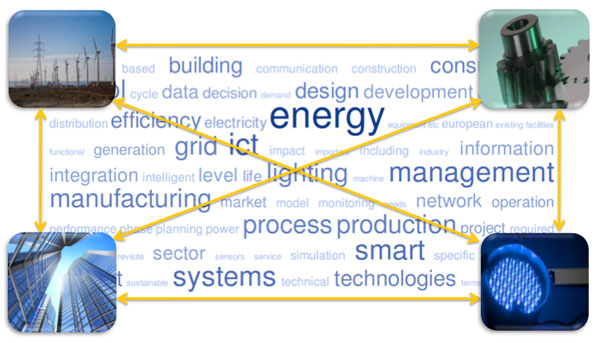ICT4EE Knowledge and Current Practices
The REViSTE project conducted a extensive review of the "state of the knowledge and practice" detailing that which is homogenous, heterogeneous and synergetic across the projects four target sectors in terms of ICT enabled Energy Efficiency. Starting point is a sector specific state of the art review. It describes individually the sector characteristics and its framework, the individual energy profile and most important the usage of RTDs in terms of ICT enabled energy efficiency. The RTDs are classified by using the REViSTE SMARTT taxonomy, which proves very useful in order to speak a common language across the sectors and to not compare apples and oranges.
In a second step REViSTE conducted a synthesis by identifying the most promising links, common themes and RTD trends between the sectors, which are mainly in the fields of:
- ICT for assessment
- Lifecycle thinking as an integrative approach across the sectors
- No commonly means for quantifying the impact on EE of ICTs
- Development of ICTs for quantitative assessment required
- ICT for Design
- Holistic information systems such as PLM or BIM need to be enhanced for design for EE
- Feedback mechanism required in order to bring EE related knowledge back into design phase
- Holistic simulation / estimation of energy uses required
- ICT for automated monitoring/control and operational decision support
- Sense, understand, decide, act in energy conscious way
- Smart sensor networks (wired and wireless)
- HEMs, BMS etc for visualisation and decision support
- Intelligent energy based algorithms for automated control systems
- ICT for trading
- Management of energy information on macro down to micro level
- Intelligent energy trading management
- ICT for interoperability
- Technical and semantic integration across the sectors
- Protocols and standards for data exchange
- Middleware for smart information network

The state of the art review concludes with themes and gaps identified as being critical to ICT enabled Energy Efficiency e.g.:
- Technical interoperability & standards (Work package 3)
- Importance of design for EE
- Gap in clearly defined metrics/ methods for quantitative assessment
- Difficulty in sustaining the casual connection between RTD themes
- Importance of data visualisation and decision support particularly in "usage phase"
The summary sheet of the report is available here.
The main report is available here.
The technical report on ICT4EE Knowledge and Current Practices is available here.
Our choice from the blog ...
REViSITE Workshop on “ICT for Energy Efficiency: Cross–sectoral Interoperability”
Read more ...
REViSITE releases its initial Strategic Research Agenda (SRA)
Read more ...
REViSITE launches online questionnaire on its Strategic Research Agenda
Read more ...
REViSITE and Commission Workshops at the CIB W78 Conference in Sophia Antipolos, October 2011
Read more ...
REViSITE Blogs ...
REViSITE ITU ‘Green Standard Week’
Read more ...




